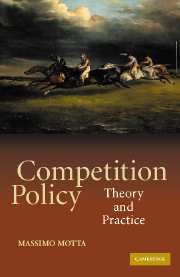Book contents
- Frontmatter
- Dedication
- Contents
- List of Figures
- List of Tables
- Preface
- Acknowledgements
- List of Abbreviations
- 1 Competition Policy: History, Objectives, and the Law
- 2 Market Power and Welfare: Introduction
- 3 Market Definition and the Assessment of Market Power
- 4 Collusion and Horizontal Agreements
- 5 Horizontal Mergers
- 6 Vertical Restraints and Vertical Mergers
- 7 Predation, Monopolisation, and Other Abusive Practices
- 8 A Toolkit: Game Theory and Imperfect Competition Models
- Bibliography
- References to Cases and Legislation
- Index
7 - Predation, Monopolisation, and Other Abusive Practices
Published online by Cambridge University Press: 05 August 2015
- Frontmatter
- Dedication
- Contents
- List of Figures
- List of Tables
- Preface
- Acknowledgements
- List of Abbreviations
- 1 Competition Policy: History, Objectives, and the Law
- 2 Market Power and Welfare: Introduction
- 3 Market Definition and the Assessment of Market Power
- 4 Collusion and Horizontal Agreements
- 5 Horizontal Mergers
- 6 Vertical Restraints and Vertical Mergers
- 7 Predation, Monopolisation, and Other Abusive Practices
- 8 A Toolkit: Game Theory and Imperfect Competition Models
- Bibliography
- References to Cases and Legislation
- Index
Summary
INTRODUCTION
This chapter deals mainly with exclusionary practices, that is, practices carried out by an incumbent with the aim of deterring entry or forcing the exit of rivals. By and large, such practices correspond to the legal concepts of monopolisation in the US and abuse of dominance in the EU (see Chapter I).
The identification of exclusionary behaviour is one of the most difficult topics in competition policy, as often exclusionary practices cannot be easily distinguished from competitive actions that benefit consumers. For instance, suppose that following entry into an industry a dominant firm reduces its prices considerably: should this be considered an anti-competitive strategy aimed at forcing the new entrant out of the industry (after which prices will be raised again, damaging consumers in the long-run), or is it instead just a competitive response that will be beneficial to consumers? Most of this chapter will be devoted to understanding how to answer this question.
Exclusionary practices by incumbents are certainly not a new phenomenon, but there are at least two reasons why such practices should receive fresh attention. The first is that in many countries there have been processes of liberalisation, privatisation, and deregulation that have resulted in several sectors having an incumbent facing potential entrants. This asymmetric structure creates strong incentives for potential exclusionary behaviour. The second is that a growing share of today's advanced economies is composed of sectors (for example computer software, Internet and telecommunications) that exhibit network and lock-in effects. In such environments, entrants might find it very difficult to compete with incumbents, and particular attention should be paid to possible exclusionary practices.
Section 7.2 focuses on pricing strategies, and Section 7.3 on non-pricing strategies, such as over-investment, tying and bundling, and incompatibility choices.
- Type
- Chapter
- Information
- Competition PolicyTheory and Practice, pp. 411 - 532Publisher: Cambridge University PressPrint publication year: 2004



